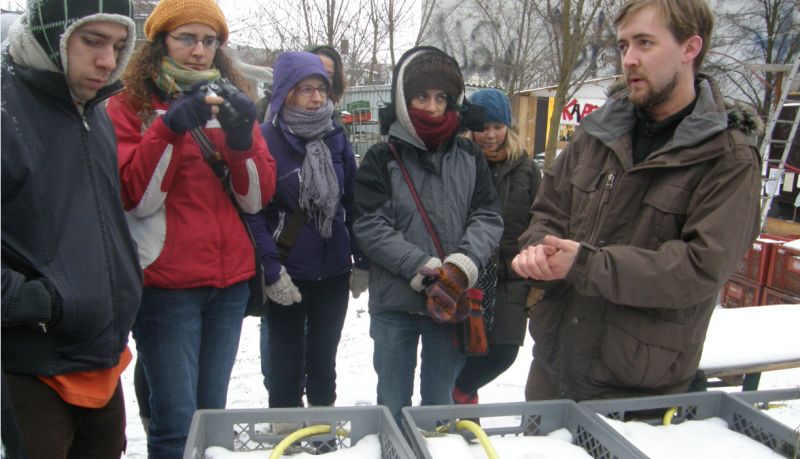Written by Matthew Keyes, YFoEE Food & Agriculture working group member
During the ReCAP Berlin meeting, we had the opportunity to learn on the field how the people in Berlin are ReCAP-turing the food and the land (and also democracy) with a very successful initiative in the core of the city.
We arrived at Prinzessinnengärten on a very chilly Friday afternoon in January to view an urban garden. Not the best time to visit a garden, especially when it is covered in two or three inches of snow which is why the first thing that our guide Jonathan said was ‘you’re going to need to use your imaginations for the next hour’? Luckily we had a great guide and storyteller.
ALWAYS BREAK IN
That was the first piece of advice given when considering taking over unused land and turning it into a useful green urban garden. The spirit of the message being not that you should necessarily break into someone’s back garden or property and start growing vegetables (we leave that to the Lawn Liberation Front), but that you should not let local authorities delay you from starting a project and dragging all the initial excitement and energy out of it.*
Prinzessinnengärten began in just this way, when the founder put an advert up calling for 25 people to come and help clear the wasteland land which it now sits up on. On the day 125 people showed up, all eager to dig, cut and clear the land. Today there are many more people involved and the site has thousands of plastic packing crates set up in rows. The land had previously been used to store second hand cars. As a result the soil was deemed to be too polluted to grow anything edible on, and too expensive for volunteers to be able to clean up.
Prinzessinnengärten was partially inspired by the growing revolution that has taken place in Cuba in the last 25 years. In Cuba, they grow about 70% of the vegetables consumed we were told. Quite a staggering amount compared to other countries. Some gardens in Cuba are designed to be moveable, partially due to a scarcity of land. This was the inspiration for the box growing in Prinzessinnengärten, although after the success of the project they may have trouble moving all of the soil they have stored in those boxes.
BUILD A BAR
Another fantastic tip, passed on from Jonathan, was to build a bar. It is a hassle to get permission initially, but it provides revenue and creates a social space for people to relax after gardening and for new people to come along and have a look at what is happening. They charge for coffee, but they offer free tea, though you do have to go and pick the tealeaves yourself. The bar points to a crucial element of the garden and its success. It is a place for people to come and do some hardwork and then relax afterwards, but it is also a place that welcomes people in. The garden has created a social space to share and enjoy, and also to learn new skills, with everything from germinating seeds to welding being shared.
There may not have been a lot of life sprouting up through the snow when we visited but underneath the frozen boxes there is a lively community of people who are passionately working and sharing food and skills. Prinzessinnengärten is an example of how we can all engage with growing food whether we live in a city, a village or a farm. So let’s get to it!
* Make sure you’re fully aware of all the legal risks associated with any action before you carry it out.

